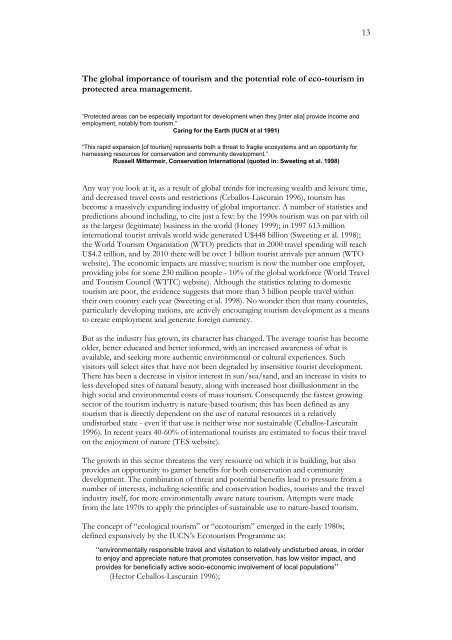The Unfenced Desert Towards a strategy for eco ... - Nwrc.gov.sa
The Unfenced Desert Towards a strategy for eco ... - Nwrc.gov.sa
The Unfenced Desert Towards a strategy for eco ... - Nwrc.gov.sa
You also want an ePaper? Increase the reach of your titles
YUMPU automatically turns print PDFs into web optimized ePapers that Google loves.
<strong>The</strong> global importance of tourism and the potential role of <strong>eco</strong>-tourism in<br />
protected area management.<br />
“Protected areas can be especially important <strong>for</strong> development when they [inter alia] provide income and<br />
employment, notably from tourism.”<br />
Caring <strong>for</strong> the Earth (IUCN et al 1991)<br />
“This rapid expansion [of tourism] represents both a threat to fragile <strong>eco</strong>systems and an opportunity <strong>for</strong><br />
harnessing resources <strong>for</strong> conservation and community development.”<br />
Russell Mittermeir, Conservation International (quoted in: Sweeting et al. 1998)<br />
Any way you look at it, as a result of global trends <strong>for</strong> increasing wealth and leisure time,<br />
and decreased travel costs and restrictions (Ceballos-Lascurain 1996), tourism has<br />
b<strong>eco</strong>me a massively expanding industry of global importance. A number of statistics and<br />
predictions abound including, to cite just a few: by the 1990s tourism was on par with oil<br />
as the largest (legitimate) business in the world (Honey 1999); in 1997 613 million<br />
international tourist arrivals world wide generated U$448 billion (Sweeting et al. 1998);<br />
the World Tourism Organi<strong>sa</strong>tion (WTO) predicts that in 2000 travel spending will reach<br />
U$4.2 trillion, and by 2010 there will be over 1 billion tourist arrivals per annum (WTO<br />
website). <strong>The</strong> <strong>eco</strong>nomic impacts are massive; tourism is now the number one employer,<br />
providing jobs <strong>for</strong> some 230 million people - 10% of the global work<strong>for</strong>ce (World Travel<br />
and Tourism Council (WTTC) website). Although the statistics relating to domestic<br />
tourism are poor, the evidence suggests that more than 3 billion people travel within<br />
their own country each year (Sweeting et al. 1998). No wonder then that many countries,<br />
particularly developing nations, are actively encouraging tourism development as a means<br />
to create employment and generate <strong>for</strong>eign currency.<br />
But as the industry has grown, its character has changed. <strong>The</strong> average tourist has b<strong>eco</strong>me<br />
older, better educated and better in<strong>for</strong>med, with an increased awareness of what is<br />
available, and seeking more authentic environmental or cultural experiences. Such<br />
visitors will select sites that have not been degraded by insensitive tourist development.<br />
<strong>The</strong>re has been a decrease in visitor interest in sun/sea/<strong>sa</strong>nd, and an increase in visits to<br />
less developed sites of natural beauty, along with increased host disillusionment in the<br />
high social and environmental costs of mass tourism. Consequently the fastest growing<br />
sector of the tourism industry is nature-based tourism; this has been defined as any<br />
tourism that is directly dependent on the use of natural resources in a relatively<br />
undisturbed state - even if that use is neither wise nor sustainable (Ceballos-Lascurain<br />
1996). In recent years 40-60% of international tourists are estimated to focus their travel<br />
on the enjoyment of nature (TES website).<br />
<strong>The</strong> growth in this sector threatens the very resource on which it is building, but also<br />
provides an opportunity to garner benefits <strong>for</strong> both conservation and community<br />
development. <strong>The</strong> combination of threat and potential benefits lead to pressure from a<br />
number of interests, including scientific and conservation bodies, tourists and the travel<br />
industry itself, <strong>for</strong> more environmentally aware nature tourism. Attempts were made<br />
from the late 1970s to apply the principles of sustainable use to nature-based tourism.<br />
<strong>The</strong> concept of “<strong>eco</strong>logical tourism” or “<strong>eco</strong>tourism” emerged in the early 1980s;<br />
defined expansively by the IUCN’s Ecotourism Programme as:<br />
“environmentally responsible travel and visitation to relatively undisturbed areas, in order<br />
to enjoy and appreciate nature that promotes conservation, has low visitor impact, and<br />
provides <strong>for</strong> beneficially active socio-<strong>eco</strong>nomic involvement of local populations”<br />
(Hector Ceballos-Lascurain 1996);<br />
13

















